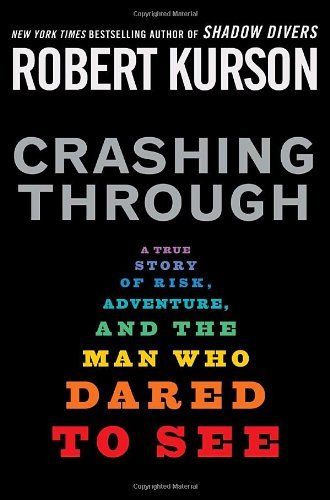The book “Crashing Through” by New York Times bestselling author Robert Kurson includes innumerable reflections about struggle, collaboration, and victory that also apply to the sphere of facilitation.
Most importantly, the book emphasizes the scientific understanding that pre-existing knowledge affects perception. In other words, what you know changes what you see. The challenges around consensual decision-making are thus amplified by the plurality of the group.
Sight recovery after a lifetime of being visually impaired is extraordinarily rare. Only around 20 people in known history have had their vision restored in adulthood after being visually blind since early youth. As explained by Kurson, he captures Mike May’s “true story of risk, adventure, and the man who dared to see.” Suffice it to say that vision and the brain’s role supporting it is massively complex.
Visually impaired, but not without vision
Keep in mind that Mike May, while blind, established world records in downhill skiing. He also became a co-inventor of the world’s first laser turntable and was the first blind person hired by the CIA (Central Intelligence Unit). In Mike May’s words, “Life with vision is great. But life without vision is great too.”
The optic nerve is technically part of the brain. It can also transmit perfect signals from the cornea region of the eye that can be rendered uniquely in each person’s mind based on what they know when they receive the signal. In other words, two people can look at the same scene and see different things. That’s probably not a surprise if you are a trained facilitator, but it becomes increasingly important that you emphasize the diversity of perception and the simple fact that there is more than one right answer.
Details of perception
The story explores the details and science to support its conclusion that perception relies largely on prior life experiences and the judgments those experiences have brought to each of us. For example, some of May’s problems are related to depth perception. While he saw horizontal lines, most of us would have instantly recognized a stairway, and would not have crashed down or up the stairs, unlike May.
He was largely unable to determine sexual gender by looking only at the face of someone. It’s not important that facilitators discriminate, but it is rather curious and significant that our preconceptions about small details such as eyebrow width or color nuances lead us to conclusions, that may be wrong.
______
Don’t ruin your career by hosting bad meetings. Sign up for a workshop or send this to someone who should. MGRUSH workshops focus on meeting design and practice. Each person practices tools, methods, and activities every day during the week. Therefore, while some call this immersion, we call it the road to building high-value facilitation skills.
Our workshops also provide a superb way to earn up to 40 SEUs from the Scrum Alliance, 40 CDUs from IIBA, 40 Continuous Learning Points (CLPs) based on Federal Acquisition Certification Continuous Professional Learning Requirements using Training and Education activities, 40 Professional Development Units (PDUs) from SAVE International, as well as 4.0 CEUs for other professions. (See workshop and Reference Manual descriptions for details.)
Want a free 10-minute break timer? Sign up for our once-monthly newsletter HERE and receive a timer along with four other of our favorite facilitation tools, free.

Terrence Metz, president of MG RUSH Facilitation Training, was just 22-years-old and working as a Sales Engineer at Honeywell when he recognized a widespread problem—most meetings were ineffective and poorly led, wasting both time and company resources. However, he also observed meetings that worked. What set them apart? A well-prepared leader who structured the session to ensure participants contributed meaningfully and achieved clear outcomes.
Throughout his career, Metz, who earned an MBA from Kellogg (Northwestern University) experienced and also trained in various facilitation techniques. In 2004, he purchased MG RUSH where he shifted his focus toward improving established meeting designs and building a curriculum that would teach others how to lead, facilitate, and structure meetings that drive results. His expertise in training world-class facilitators led to the 2020 publication of Meetings That Get Results: A Guide to Building Better Meetings, a comprehensive resource on effectively building consensus.
Grounded in the principle that “nobody is smarter than everybody,” the book details the why, what, and how of building consensus when making decisions, planning, and solving problems. Along with a Participant’s Guide and supplemental workshops, it supports learning from foundational awareness to professional certification.
Metz’s first book, Change or Die: A Business Process Improvement Manual, tackled the challenges of process optimization. His upcoming book, Catalyst: Facilitating Innovation, focuses on meetings and workshops that don’t simply end when time runs out but conclude with actionable next steps and clear assignments—ensuring progress beyond discussions and ideas.




